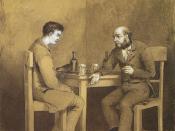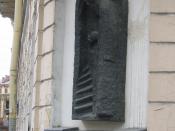Crime and Punishment
Around about the mid 1800s Emily Dickinson hit the nail on the head with a line from a poem she wrote: Part One: Life. Emily wrote "Much madness I divinest sense/ To a discerning eye" which holds true for writers of all types in the past, present and future. The same stands for Fyodor Dostoevsky's Crime and Punishment, where the lead character, Rodion Raskolnikov, demonstrates multiple stages of craziness but when examined by the a sensible reader his actions seem to be profound logic.
As the novel begins Raskolnikov shows the first signs of madness, contemplating murdering an elderly pawnbroker for the reason the he considers her to be a "louse". He then brutally slaughters her and her sister, who happens to walk in and catch him in the act; takes some money and items from her dresser drawer but does not spend it. Instead he hides it under a rock and doesn't return for the lute.
After the murder Raskolnikov falls ill or at least he thinks he is ill, and becomes irritated by all human contact. His doctor, Dr. Zossimov, feels that Raskolnikov has some sort of monomania and the Dr. has "some suspicions of insanity." Dr. Zossimov is not the only one to see Raskolnikov's strange ways, Razumihin, Raskolnikov's friend, thinks Raskolnikov to be "simply cold and inhumanely callous"(Dostoevsky 187). Raskolnikov is even blunt and rude to the one person who he has not turned away or has not turned him away, Sonia, when he attacks her way of life and religion (279). Raskolnikov also has a intense fear of water, one he never had before the murders, that increase as the novel progresses and climaxes as he considers jumping into the river to end his life but is to afraid of the...


